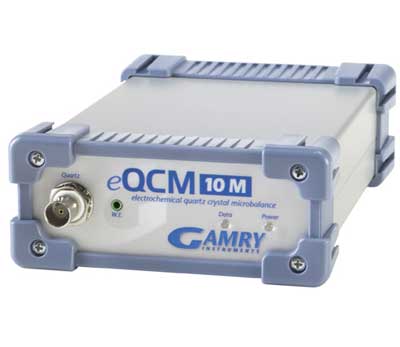Gamry's eQCM 10M™ is a fast impedance scanning electrochemical quartz crystal microbalance (EQCM). EQCM is one of the most valuable tools in any toolbox for anyone studying interface processes. Corrosion, ion intercalation, ion adsorption, polymer growth, and sensor binding events are all interfacial processes that induce mass changes. These mass changes can be measured by monitoring the resonant frequency of the oscillating quartz crystal.
石英晶体微天平
产品详细信息
The eQCM 10M is a general purpose instrument that can accommodate any crystal from 1-10 MHz in any cell or holder. Its resolution can detect mass changes in the order of ng /cm. This is lighter than a single layer of material! We also provide everything you need with the system – eQCM 10M, Teflon® electrochemical cell, 10 MHz gold-coated crystals (5x), cables, manuals and software.
feature
- Any crystal from 1-10 MHz in any cell
- Detection ng/cm 2
- USB interface
- Integrated QCM and Gamry potentiostat acquisition
- Impedance sweep has ƒ s and ƒ p , the series resonance and parallel resonance frequencies
- Data analysis in Gamry's flexible and customizable Echem Analyst™
application
- Electroactive polymers
- Li+ Embedding
- Corrosion Research
- Electrodeposition
- self-assembled monolayer
- antigen-antibody interaction
- Surfactant adsorption
- protein adsorption
- Ion and Solvent Transport
The eQCM 10M rapidly sweeps a frequency window around two resonant frequencies (see the eQCM Fundamentals application note for an explanation of these resonant frequencies ). The advantage of sweeping through two resonant frequencies is that you no longer need to cancel the parasitic capacitance in order to maintain oscillation. In addition, the associated impedance spectrum is displayed each time a data point is acquired, giving you greater insight into the formation of air bubbles on the electrodes or incorrect cell settings. Having two resonant frequencies enables you to perform basic dissipation monitoring. When the ƒs and ƒp responses are similar, the membrane is already stiffer, and when the ƒs and ƒp responses are different, the membrane is not yet stiffer.
You can use the resonator to adjust the drive amplitude of the crystal. This is important when working in ionic liquids (IL) or viscous solutions where damping is particularly high. Being able to manually increase the drive amplitude of a heavily loaded crystal offers significant advantages over direct dissipation or time-resolved techniques.
Data analysis is done in our flexible and customizable Echem Analyst™. We give you a variety of plotting options so you can display your data the way you want. You can graph direct mass change versus time, mass versus charge, mass versus potential, or fundamental form dissipation versus time.
Other accessories for QCM include:
- 10 MHz Pt Coated Crystal
- 10 MHz C-Coated Crystal
- 10 MHz Fe Coated Crystal
- 10 MHz blank crystal (with Au/Ti layer on one side)
- EQCM flow cell and Ag/AgCl reference electrode
规格
Specification
All specifications are subject to change without notice.
Frequency measurement
|
Scope |
1– 10 |
MHz |
|
Resolution |
0.02 |
Hz |
environment
|
Operating temperature range |
|
0 to 45 |
°C |
|
Relative humidity |
high |
90 (non-condensing) |
% |
|
Storage and Shipping Temperature |
|
-25 to 75 |
°C |
|
Great transport acceleration |
|
30 |
G |
conventional
|
Power input voltage |
Scope |
10 to 14 |
Volt |
|
power supply |
high |
25 |
W |
|
size |
Big |
175 x 115 x 80 |
mm |
|
weight |
high |
1 |
kg |
|
External Power Adapter Dimensions |
Big |
120 x 55 x 30 |
mm |
|
External power adapter weight |
high |
400 |
gram |
A PHE200 license is required for the resonator to control the Gamry potentiostat.
System Requirements
- USB 2.0 port
- Microsoft® Windows™ XP SP3/Vista/7 (32-bit or 64-bit)


